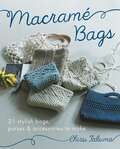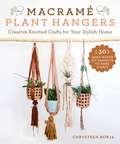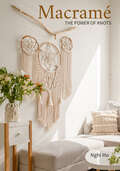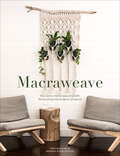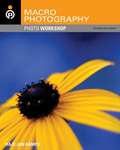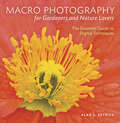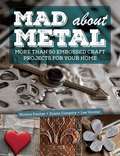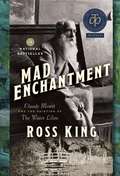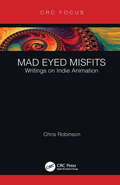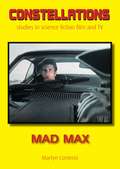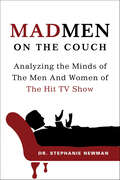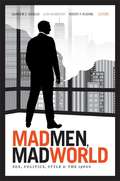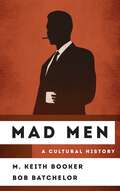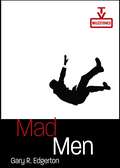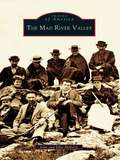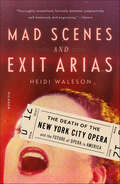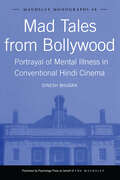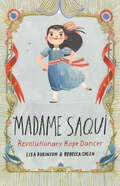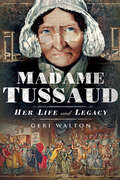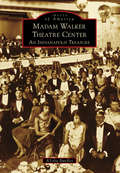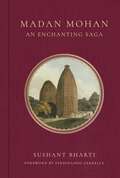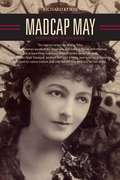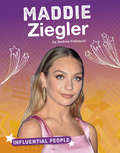- Table View
- List View
Macramé Bags: 21 Stylish Bags, Purses & Accessories to Make
by Chizu TakumaCraft your own stylish accessories worthy of a high-end boutique with this collection of 21 macramé bags, belts, and straps.From durable market totes to cross-body boho bags, there&’s a purse for every occasion. After mastering basic macramé techniques, discover how to add special details, such as wooden handles, metal buckles, and zippers, to elevate the style and function of your designs. With its assortment of small-scale projects, this book is great for beginners, but also provides fresh inspiration for veteran macramé enthusiasts looking to create wearable art.
Macramé Plant Hangers: 30 Creative Knotted Crafts for Your Stylish Home
by Chrysteen BorjaAdorn your cozy interiors with hand-woven knotted art and hanging plants.Are you a DIY home decorator, plant lover, or flower lover? We got you!Macramé plant hangers are the perfect little touch to accent your cozy, designer home. Macramé—the art of knotting made popular in the seventies—is now on a revival, bringing trendy boho vibes into your living room, bedroom, and more. And there&’s simply no better way to display your hanging plants than stringing them up in handmade woven knots.Whether you&’re a novice or seasoned knotter, Macramé Plant Hangers provides thirty quirky, yet stunning projects that will spark your DIY artist&’s imagination and get you creating. Follow detailed photographs and instructions to construct patterns with various natural fibers, including cotton rope, felted wool, silk ribbon, jute, recycled fabric, and more. There are knotted projects suitable for bigger eight-inch pots, small four-inch pots, vintage bottles, and even air plants.Including a practical beginner&’s section of knot basics; an introduction to weaving; customizable variations to add playful beads, funky fringes, and chic rope tassels to your macramé design for &“whimsy&”; and a bonus chapter on special projects that mix macramé with a dash of weaving and earthy elements, Macramé Plant Hangers is your handy guidebook to adorning interiors with your own custom hand-knotted, vintage art you can be proud of—while keeping it green!
Macramé: The Power of Knots
by Nghi HoLearn and Master the Art of Macramé“A wonderful resource for beginning and advanced macramé artists.” ―Elizabeth Majka, Library Journal#1 New Release in Ribbons, Knots, Macrame & Rope WorkLearn the art of macramé and craft beautiful and practical creations such as wall hangings, plant hangers, jewelry, and much more.Develop a new creative hobby or just improve your macramé skills. New to macramé or an accomplished macramé artist? Either way, with the expert guidance of author Nghi Ho, online macramé community star and founder of Miss Knottie Macramé supplies, you’ll discover new macramé patterns and projects and a whole world of enjoyment and satisfaction.Relax with macramé DIY crafts. Having a stressful day? Unwind with a macramé project that can be both gratifying and fun. If you are new to macramé, Nghi Ho will show you how to get started, explain the basic materials you’ll need, and give you a good grounding in macramé knots.Inside find:Tutorials on starting your own macramé projects, macrame kits, and basic knotsCrafts to do at home and fun activities for the whole familyMacramé projects that are unique and personalizedIf you have read books like Macramè For Beginners, Statement Macramé, or Modern Embroidery, you’ll love Nghi Ho’s Macramè: The Power of Knots.
Macraweave: Macrame Meets Weaving with 18 Stunning Home Decor Projects
by Amy Mullins Marnia Ryan-RaisonDiscover the exciting new craft that brings together two timelessly popular fiber arts to make beautiful, eye-catching pieces for your home. Learn to create stunning woven wall hangings and inject a dose of &“bohemian luxe&” to your living space. Macraweavecombines the crafts of macramé knotting with weaving to create eye-catching projects that really pop with texture and color. There are eighteen projects to choose from including woven wall hangings, table mats, plant hangers and cushions as well as accessories such as jewelry. All the instructions and projects are illustrated with step-by-step photography.
Macro Photography Photo Workshop
by Haje Jan KampsSpecial techniques for creating unique, artistic, close-up images Macro, or close-up, photography is gaining popularity, and this book covers all of the challenges associated with taking great close-ups: depth of field, focus, and exposure. Copublished with Photoworkshop. com, a leading online educational resource for both beginning and professional photographers, this task-oriented reference allows readers to learn by doing and offers outstanding examples and instructions.
Macro Photography for Gardeners and Nature Lovers: The Essential Guide to Digital Techniques
by Alan L. DetrickGardeners and nature lovers delight in taking pictures—especially close-ups of flowers, butterflies, and insects. And though advances in digital camera technology have made taking, storing, and sharing photos easier than ever, taking top-quality pictures requires familiarity with both digital technology and the general principles of photography. Macro Photography for Gardeners and Nature Lovers provides exactly the information that aspiring photographers—no matter their level of skill—need to take their photos to the next level. Clear and concise chapters cover the basics of macro (close-up) photography, explain the features of current digital single-lens reflex cameras, show the many ways images can be composed, and share tips on digital effects, storage, and manipulation of imagery. Throughout the text, helpful tips, definitions, exercises, and case studies serve to demystify digital photography. Each lesson is supported by examples of the author's stunning photography. Whether taking photos of flowers and insects, compiling a photographic record of your garden, or simply sharing beautiful images with friends and family, everyone can become accomplished photographers of the world's small-scale wonders.
Macrophotography
by Dennis QuinnMacrophotography allows for the capture of small photographic subjects in life size or larger magnification, allowing viewers to experience the world around them in a way that is simple not possible with the naked eye. With a magnified view, we can see the distinctive make-up of an insect, animal, or flower--its texture, details, and subject features that we might otherwise be completely unaware of. In this unique book, Dennis Quin turns his macro lenses upon the natural world and teaches readers to choose and use the tools they need to capture magical images of all manner of bugs, flowers, reptiles, and more. In each of the 60 sections in this beautifully illustrated book, Quin details the tricks of the trade. You’ll learn where to find your subjects, how to make sure that the background adds to the overall impact of the image, how to track insects in flight, and other skills that will increase your odds of capturing technically strong, visually rewarding shots. In each section, you’ll see 1 to 3 images of a unique subject and will get detailed instruction as to how Quin shot the image--including the equipment used, settings chosen, the camera angle, and more. There’s more to this book than instructional photographic text. In each of the 60 discrete sections, Quin provides fascinating tidbits about each animate object--describing the life cycle, feeding habits, mating rituals, breeding, and much more--or characteristics of botanical subjects. This book provides an inspiring and enlightening blend of photographic technique and fascinating science lessons. It is perfect for serious amateur photographers, wildlife/landscape photography enthusiasts, and even those whose "bread and butter” shots are in another genre completely. The book is sure to impress.
Mad About Metal: More Than 50 Embossed Craft Projects for Your Home
by Monica Fischer Susan CumpstyCraft metal has endless decorative possibilities. It is pliable and can be wrapped around or adhered to any surface you can imagine. This book is all about using colored craft metal? decorating it by means of embossing, cutting out designs, adding further color, taking away color and filling in 3D designs, and much more?to customize found objects for your home. You will learn more about the metal and supporting mediums, as well as how to use the tools and familiarize yourself with several techniques?all of which can be applied in making more than fifty decorative and functional items provided in this book. The original projects were designed and created specifically to showcase a variety of techniques and applications, including: Transferring and tracing designs Creating texture by means of inexpensive handheld tools or manual processes Using an embossing machine such as the cuttlebug? for textures, patterns and die-cuts Finishing techniques such as sanding, ageing and painting Upcycling and repurposing Tips and tricks to simplify processes The projects range from beginner to advanced levels and from quick ideas to masterpieces that will take longer to complete. Magnificent photographs of the finished objects will inspire you while step-by-step instructions and photographs will help you to get started right away.
Mad Enchantment: Claude Monet and the Painting of the Water Lillies
by Ross KingAcclaimed historian Ross King paints the most nuanced, riveting and humane portrait yet of Claude Monet, arguably the most famous artist of the 20th century.We have all seen--live, in photographs, on postcards--some of Claude Monet's legendary water lily paintings. They are in museums all over the world, and are among the most admired paintings of our time. Yet nobody knows the extraordinarily dramatic story behind their creation. Telling that story is the brilliant historian, Ross King--and in the process, he presents a compelling and original portrait of perhaps the most beloved artist in history. As World War I exploded within hearing distance of his house at Giverny, Monet was facing his own personal crucible. In 1911, his adored wife, Alice, had died, plunging him into deep mourning at age 71. A year later he began going blind. Then, his eldest son, Jean, fell ill and died of syphilis, and his other son was sent to the front to fight for France. Within months, a violent storm destroyed much of the garden that had been his inspiration for some 20 years. At the same time, his reputation was under attack, as a new generation of artists, led by Pablo Picasso and Henri Matisse, were dazzling the art world and expressing disgust with Impressionism. Against all this, fighting his own self-doubt, depression and age, Monet found the wherewithal to construct a massive new studio, 70 feet long and 50 feet high, to accommodate the gigantic canvases that would, he hoped, revive him. Using letters, memoirs and other sources not employed by other biographers, and focusing on this remarkable period in the artist's life, Ross King reveals a more complex, more human, more intimate Claude Monet than has ever been portrayed, and firmly places his water lily project among the greatest achievements in the history of art.From the Hardcover edition.
Mad Eyed Misfits: Writings on Indie Animation
by Chris RobinsonOne of the most stylistically original and provocative writers in animation returns with this informal sequel to his previous books on indie animation, Unsung Heroes of Animation and Animators Unearthed. In this collection, award-winning writer Chris Robinson looks at a wide range of films and filmmakers, including cult favourites Don Hertzfeldt, Adam Elliot, Masaaki Yuasa, Wong Ping, Bruce Bickford, Jodie Mack, Rosto, Suzan Pitt, Clyde Henry and Cartoon Saloon. Eclectic, opinionated, passionate and personal, Robinson’s writing will amuse, confuse, infuriate and enlighten while introducing readers to some of the most astonishing and important animation artists from around the world.
Mad Max (Constellations)
by Martyn ConterioMad Max (1979) is a freak picture. Too classy and well-crafted to be lumped in with low-budget Ozploitation titles, yet completely unlike other films made during the 1970s Australian New Wave, George Miller’s directorial debut is a singular piece of action cinema, one that had a major cultural impact and spawned a movie icon in Max Rockatansky (played by Mel Gibson). This monograph examines the film’s considerable formal qualities in detail, including Miller’s theory of cinema as “visual rock ‘n’ roll” and his marriage of classical Hollywood editing and Soviet-style montage. George Miller is arguably the single most important filmmaker in Australia’s history, bringing a commercial and artistic vision to the screen few of his compatriots have ever managed before or since. Taking in everything from the film’s extremely controversial critical reception to its legacy today via a string of sequels and the creation of an entire subgenre—postapocalyptic action—the book is for film students and fans alike.
Mad Men on the Couch: Analyzing the Minds of The Men And Women of The Hit TV Show
by Stephanie NewmanMad Men has captured the imaginations of millions of viewers, winning fifteen golden globes and four Emmys. Perhaps more than the gorgeously stylized visuals and impeccably re-created history, it's the show's richly drawn characters stumbling through their personal and professional lives that get under our skin and keep us invested.In Mad Menon the Couch, Dr. Stephanie Newman analyzes the show's primary characters through the lens of modern psychology. Lending her trained professional eye, she poses and expertly answers pressing questions such as:Why does Don constantly sabotage himself? Why is Betty such a cold mother and desperately unhappy housewife? (Hint: It's not just because her "people are Nordic.")Why does Pete prevail in adversity when Roger crumbles?Why is Peggy able to rise profesionally in the male jungle of Madison Avenue when Joan can't?Can these characters ever really change?With critical commentary that is both entertaining and insightful, Mad Men on the Couch will provide viewers with a unique persepctive on the show.
Mad Men, Mad World: Sex, Politics, Style, and the 1960s
by Lilya Kaganovsky Robert A. Rushing Lauren M. E. GoodladSince the show's debut in 2007, Mad Men has invited viewers to immerse themselves in the lush period settings, ruthless Madison Avenue advertising culture, and arresting characters at the center of its 1960s fictional world. Mad Men, Mad World is a comprehensive analysis of this groundbreaking TV series. Scholars from across the humanities consider the AMC drama from a fascinating array of perspectives, including fashion, history, architecture, civil rights, feminism, consumerism, art, cinema, and the serial format, as well as through theoretical frames such as critical race theory, gender, queer theory, global studies, and psychoanalysis. In the introduction, the editors explore the show's popularity; its controversial representations of race, class, and gender; its powerful influence on aesthetics and style; and its unique use of period historicism and advertising as a way of speaking to our neoliberal moment. Mad Men, Mad World also includes an interview with Phil Abraham, an award-winning Mad Men director and cinematographer. Taken together, the essays demonstrate that understanding Mad Men means engaging the show not only as a reflection of the 1960s but also as a commentary on the present day. Contributors. Michael Bérubé, Alexander Doty, Lauren M. E. Goodlad, Jim Hansen, Dianne Harris, Lynne Joyrich, Lilya Kaganovsky, Clarence Lang, Caroline Levine, Kent Ono, Dana Polan, Leslie Reagan, Mabel Rosenheck, Robert A. Rushing, Irene Small, Michael Szalay, Jeremy Varon
Mad Men: A Cultural History (The Cultural History of Television)
by M. Keith Booker Bob Batchelor&“A comprehensive examination of the ways in which [the series] uses American cultural memory . . . to shape . . . characters&’ developments and the narrative arc.&” —Journal of American Culture From the opening credits that feature a silhouette falling among skyscrapers, Mad Men transcended its role as a series about the Madison Avenue advertising industry to become a modern classic. For seven seasons, Mad Men asked viewers to contemplate the 1960s anew, reassessing the era&’s stance on women&’s rights, race, war, politics, and family relationships that comprise the American Dream. Set in the mid-twentieth century, the show brought to light how deeply we still are connected to that age. The result is a show that continually asks us to rethink our own families, lives, work, and ethical beliefs as we strive for a better world.In Mad Men: A Cultural History, M. Keith Booker and Bob Batchelor offer an engaging analysis of the series, providing in-depth examinations of its many themes and nostalgic portrayals of the years from Camelot to Vietnam and beyond. Highly regarded cultural scholars and critics, Booker and Batchelor examine the show in its entirety, presenting readers with a deep but accessible exploration of the series, as well as look at its larger meanings and implications. This cultural history perspective reveals Mad Men&’s critical importance as a TV series, as well as its role as a tool for helping viewers understand how they are shaped by history and culture. &“This homage will appeal to fans and academic readers alike. . . . Recommended.&” —Choice &“Offers a stimulating point of view on the role of mass communication products as keys to understanding our society.&” —Journalism & Mass Communication Quarterly
Mad Men: Dream Come True Tv (TV Milestones Series)
by Gary R. EdgertonThis one-stop primer offers a succinct analysis of one of the most skillfully produced, artistically innovative, and culturally resonant scripted series in modern television. It opens by explaining how Mad Men (AMC, 2007–2015) functions as a representative example of much deeper and more profound structural changes happening in television since the 2000s. Gary R. Edgerton highlights influences driving the creation of the show, including creator Matthew Weiner’s personal connections to the subject matter and the development of the main character, Don Draper (Jon Hamm). Analysis of the show’s story progression is delineated by a pivotal shift from a culturally relevant Zeitgeist phenomenon to a narrative more concerned with Draper’s introspective and existential journey to reconciliation and self-awareness. Cultural reflections are also explored with interrogations of privilege and prejudice, the American Dream, ethnicity, race, gender politics, and class as witnessed through the program’s complex and conflicted characters. Following its debut, Mad Men quickly became a bellwether of contemporary culture. The award-winning series set the creative standard in drama over the span of its initial run and is now recognized as a milestone in the history and development of scripted television. Throughout its seven seasons, the series struck a delicate balance of being both complex and cerebral while also entertaining and accessible, a balance that Edgerton skillfully carries over to this book.
Mad River Valley, The (Images of America)
by Ellie Hilferty John HilfertyBeginning as an icy trickle in the Green Mountains of Vermont, the northward-flowingMad River and its scenic valley have changed little since being settled after the Revolutionary War. The valley's dairy farms, terraced meadows, upland forests, nineteenth-century villages, country inns, and classic ski resorts attract a half-million tourists each year. The historic photographs in The Mad River Valley show slices of daily life in the valley's five towns: Warren, Waitsfield, and Moretown, which lie in the river's path; and Fayston and Duxbury, on the valley's western slope. The area's economy, driven and sustained by river-powered mills and logging, plus sheep, then dairy farming, eventually gave way to the more spirited pastimes of skiing, hiking, fishing, and biking, all dictated by the lay of the land and the flow of the river.
Mad Scenes and Exit Arias: The Death of the New York City Opera and the Future of Opera in America
by Heidi WalesonFrom the Wall Street Journal’s opera critic, a history of how and why the New York City Opera went bankrupt—and what it means for the future of the arts.In October 2013, the arts world was rocked by the news that the New York City Opera—“the people’s opera”—had finally succumbed to financial hardship after 70 years in operation. The company had been a fixture on the national opera scene—as the populist antithesis of the grand Metropolitan Opera, a nurturing home for young American talent, and a place where new, lively ideas shook up a venerable art form. But NYCO’s demise represented more than the loss of a cherished organization: it was a harbinger of massive upheaval in the performing arts—and a warning about how cultural institutions would need to change in order to survive.Drawing on extensive research and reporting, Heidi Waleson, one of the foremost American opera critics, recounts the history of this scrappy company and reveals how, from the beginning, it precariously balanced an ambitious artistic program on fragile financial supports. Waleson also looks forward and considers some better-managed, more visionary opera companies that have taken City Opera’s lessons to heart.Above all, Mad Scenes and Exit Arias is a story of money, ego, changes in institutional identity, competing forces of populism and elitism, and the ongoing debate about the role of the arts in society. It serves as a detailed case study not only for an American arts organization, but also for the sustainability and management of nonprofit organizations across the country.“An intricate whodunit that seeks to find out who murdered the New York City Opera. . . . Waleson gives us a vivid description of each death-defying crisis and a sharp portrait of the ever-changing cast of would-be saviors who somehow always failed in their mission.” —The New York Times Book Review“Thoroughly researched, factually detailed, judgmentally well-balanced, and engrossing.” —Opera“Waleson’s in-depth study illustrates the challenges City Opera—and other opera houses—face in the 21st century as they seek to preserve tradition and innovate.” —Publishers Weekly“A thorough recounting of the tumultuous history of the New York City Opera [and] a cleareyed examination of the economic fragility of cultural institutions.” —Kirkus Reviews
Mad Tales from Bollywood: Portrayal of Mental Illness in Conventional Hindi Cinema (Maudsley Series #48)
by Dinesh BhugraThis is the first book to investigate how mental illness is portrayed in Hindi cinema. It examines attitudes towards mental illness in Indian culture, how they are reflected in Hindi films, and how culture has influenced the portrayal of the psychoses. Dinesh Bhugra guides the reader through the history of Indian cinema, covering developments from the idealism of the 1950s to the stalking, jealousy and psychopathy that characterises the films of the 1990s. Critiques of individual films demonstrate the culture’s approach towards mental illness and reflect the impact of culture on films and vice versa. Subjects covered include: Cinema and emotion Attitudes towards mental illness Socio-economic factors and cinema in India Indian personality, villainy and history Psychoanalysis in the films of the 60s. Mad Tales from Bollywood will be of interest to psychiatrists, mental health professionals, students of media and cultural studies and anyone with an interest in Indian culture.
Madame Saqui: Revolutionary Rope Dancer
by Lisa RobinsonA stunning picture book biography about the tightrope walker who dazzled Paris as she danced across the sky with impeccable balance and unparalleled skill during the French Revolution.In revolutionary France, a girl named Marguerite Lalanne longed to perform above large crowds on a tightrope, just like her acrobatic parents. Sneaking off to the fairgrounds for secret tightrope walking lessons, Marguerite finessed her performance skills, ultimately performing for crowds as a young rope dancer. And eventually, Marguerite would perform as Madame Saqui, waltzing and pirouetting across- and never falling off- countless ropes above adoring crowds. A nouvelle chérie de Paris, Madame Saqui cemented her place in circus history, winning the adoration of the French people and royalty alike, including Emperor Napoleon Bonaparte. This remarkable biography unveils the inspiring story of a trailblazing woman who revolutionized the circus world-- without ever missing a step.
Madame Tussaud: A Life in Wax
by Kate BerridgeKate Berridge’s Madame Tussaud: A Life in Wax “celebrates a great pioneer of mass-market illusion, whose illusions eventually included herself.”*Millions have visited the museums that bear her name, yet few know much about Madame Tussaud. A celebrated artist, she had both a ringside seat at and a cameo role in the French Revolution. A victim and survivor of one of the most tumultuous times in history, this intelligent, pragmatic businesswoman has also had an indelible impact on contemporary culture, planting the seed of our obsession with celebrity.Kate Berridge tells this fascinating woman’s complete story for the first time, drawing upon a wealth of sources, including Tussaud’s memoirs and historical archives. It is a grand-scale success story, revealing how with sheer graft and grit a woman born in 1761 to an eighteen-year-old cook overcame extraordinary reversals of fortune to build the first and most enduring worldwide brand identified simply by reference to its founder’s name: Madame Tussaud’s.“A good story, like Berridge’s biography, is a blessing.” —Miami Herald“A rousing good read . . . [Berridge] presents us with a thorough understanding of the beginnings of popular culture.” —Vancouver Sun“Fascinating. . . . A vividly recreated history of an extreme time and the unusually determined woman who capitalized so effectively on it.” —Globe and Mail“Spectacular and spellbinding. . . . Thoughtful, original, never condescending, erudite, and packed with vivid and sometimes horrifying detail, it is a model of how cultural history should be written.” —*Sunday Times (London)
Madame Tussaud: Her Life and Legacy
by Geri WaltonA &“meticulously researched and deftly written biography&” of the woman behind the famed wax museums, and their origins in the era of the French Revolution (Midwest Book Review). Madame Marie Tussaud is known worldwide for the chain of wax museums she started over two hundred years ago. Less known is that her original wax models were often of the famous and infamous people she personally knew during and after the French Revolution. These were people like Voltaire, Robespierre, and Napoleon—people who changed the world. Even more, the wax figures were depicted in scenes drawn from the horrors she experienced during the reign of terror in Paris during her early adult years. This book shows how the traumatic and cataclysmic experiences of Madame Tussaud&’s early life became part of her legacy. She created a succession of scenes in wax, telling events as she personally experienced them. Her wax sculptures were visceral. She made them herself, at times from the living person&’s head and at other times from the recently guillotined head of a former houseguest. As a result, people were drawn to her wax displays because they were the most intense way of experiencing those events themselves. This is the story not only of a unique artist, but of how one of history&’s bloodiest events influenced her life and work.
Madame Walker Theatre Center: An Indianapolis Treasure (Images of America)
by A'Lelia BundlesAs they watched construction of the block-long flatiron building brick by brick throughout 1927, African American residents of Indianapolis could scarcely contain their pride. This new headquarters of the Madam C.J. Walker Manufacturing Company, with its terra-cotta trimmed facade, was to be more than corporate offices and a factory for what then was one of America's most successful black businesses. In fact, it was designed as "a city within a city," with an African Art Deco theater, ballroom, restaurant, drugstore, beauty salon, beauty school, and medical offices. Generations of African American families met for Sunday dinner at the Coffee Pot, enjoyed first-run movies and live performances in the Walker Theatre, and hosted dances in the Casino. Today, this National Historic Landmark is an arts center anchoring the Indiana Avenue Cultural District.
Madan Mohan: An Enchanting Saga
by Sushant BhartiConservation Architect and Researcher Sushant Bharti highlights the significance of the Madan Mohan, an ancient and important temple in Vrindavan, India that has had a prominent impact both locally and globally throughout its history. The text includes a captivating portrayal of the temple both at home and in the Indian diaspora, a tribute to the attractive, ever enchanting nature of the structure and its spiritual potency.The establishment of Gaudiya Vaishnavas in the Braj region catalysed a novel movement centered around the devotion to Radha and Krishna. This movement, in turn, spurred construction of the Madan Mohan, one of the most significant and prominent temples in the area during the Mughal reign. In the late 16th and early 17th centuries, each temple emerged as a distinct exemple of Mughal artistry, showcasing a seamless integration of diverse architectural components and novel experimentation. The Madan Mohan temple stands as a remarkable testament to the confluence of social, economic, and political forces that transcended regional boundaries during the zenith of Mughal dominance.
Madcap May: Mistress of Myth, Men, and Hope
by Richard KurinMay Yohe was a popular entertainer from humble American origins who married and then abandoned a wealthy English Lord who owned the fabled Hope diamond--one of the most valuable objects in the world and now exhibited at the Smithsonian Institution in Washington, D.C. May was a romantic who had numerous lovers and at least three husbands--though the tabloids rumored twelve. One included the playboy son of the Mayor of New York. May separated from him--twice--and cared for her next husband, a South African war hero and invalid whom she later shot.Crossing the paths of Ethel Barrymore, Boris Karloff, Oscar Hammerstein, Teddy Roosevelt, Consuelo Vanderbilt, and the Prince of Wales, May Yohe was a foul-mouthed, sweet-voiced showgirl who drew both the praise and rebuke of Nobel laureate George Bernard Shaw. Nicknamed "Madcap May," she was a favorite of the press. In later years she faced several maternity claims and a law suit which she won. She was hospitalized in an insane asylum and escaped. She ran a rubber plantation in Singapore, a hotel in New Hampshire, and a chicken farm in Los Angeles. When all else failed, she washed floors in a Seattle shipyard, and during the Depression held a job as a government clerk. Shortly before her death, she fought, successfully, to regain her lost U.S. citizenship.How was this woman, May Yohe, able to charm her way to international repute, live an impossible life, and also find the strength to persevere in light of the losses she suffered--in wealth, citizenship, love, and sanity? Madcap May, assembled from her writings and historical interviews, archival records, newspaper stories, scrapbooks, photographs, playbills, theatrical reviews, souvenirs, and silent film, tells her heretofore lost story.
Maddie Ziegler (Influential People)
by Andrea PelleschiThe world saw Maddie Ziegler dance alongside pop star Sia. Now the young dancer is also a writer and actor. Learn more about Maddie's promising career!
